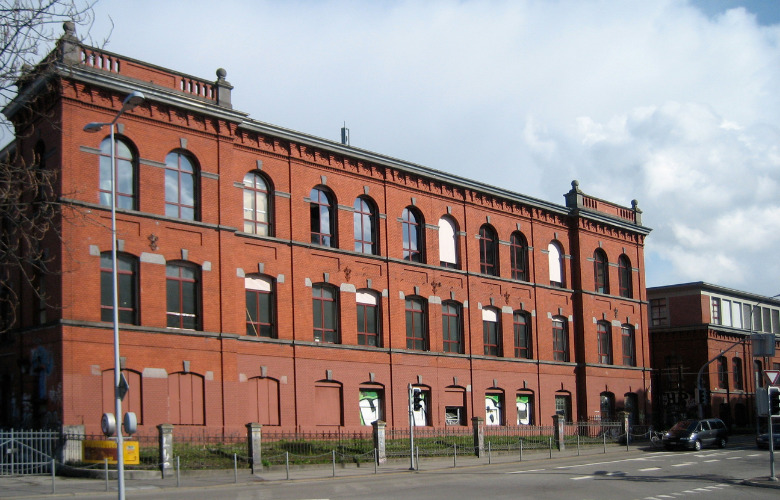
The Rote Fabrik in Zurich is a little-known cultural gem close to the center of the Swiss Metropolis. Hidden away yet easily accessible, it is located directly at Zurich’s wilder, southern lakeside. The Red Factory is a haven of alternative cultural ideas, offering creative workshops, theatre performances, concerts, festivals, and an open-air cinema showing independent movies at the lake in summer. Last year, in 2020, the alternative cultural venue celebrated its 40ieth anniversary.
As the name gives away, a long time ago the picturesque red-brick building did house an actual factory.
In 1892 the Prussian silk manufacturer Karl Gustav Henneberg built this factory. But he soon realized he preferred to collect art in his villa. So, in 1899, he sold the factory to the silk weaving mill Stuenzi and Sons.
At Stuenzi and Sons, according to a workers’ protocol from 1907, there was great solidarity among the workers. For example, they collected potatoes for the poorest amongst them.
With the rise of artificial silk fibers, however, the silk weaving company was finally plunged into ruin. Thereafter, the Red Factory stood empty for a long time.
It was supposed to be torn down to make room for the construction of the “Great Sea Tunnel” which was supposed to connect the south and north shores of Lake Zurich.
But, in 1973 the Social Party launched an initiative to preserve the Red Factory and use it as a cultural center. This initiative was approved in 1977 with a large majority.
Still, the alternative cultural scene wasn’t satisfied with the few regulated performances that were offered each year. They wanted more say in how the cultural center was going to be used. Not enough creative freedom was given.
Objectors of the rather too controlled cultural scene staged a protest outside the “elitist” opera house. It turned violent as the ranks were swelled by people coming out of a Bob Marley concert. That moment sparked months of fighting between protesters and police, who were frequently criticised for their aggressive response.
Zurich bourgeois society at the time perceived these goings on with horror as “controlled by the communist east.”
Following these protests in 1980, the young people of Zurich held unauthorized concerts in the Red Factory Hall during the same year and brought “life into the dead factory” with a festival.
Most of the wealthier Zurich city population staggered in fear that the young people would occupy the area. The occupation of vacant, unused rooms in the city of Zurich is a persistent thorn in the foot of administrators and wealthier citizens to this day.
To avert this disaster, the use of the factory was officially tolerated, and the Rote Fabrik Cultural Center opened on 25th October 1980.
The Rote Fabrik interest group was founded in 1980 and has been running the factory as a collective ever since. Since 1987, the Red Factory even became subsidized by the state.
Additionally, the organized, independent bicycle repair (autonomous bicycle repair) became a well-known feature of the rebellious alternative institution.
For the open-minded citizens of Zurich and the surrounding areas, the Red Factory at the lakeside offered a certain atmosphere rarely found in the rest of this picturesque, cleanly structured city.
There is graffiti on the walls and people who spray it in the middle of the day. There is the annual alternative open-air cinema at the lake. Which is the first and oldest open-air cinema in Zurich.
Old women and men are bathing in the nude. Giving you an uncensored, unmasked glimpse into what your own future will look like.
And then, there is the factory theater, which is an important supporter of the independent theater scene in addition to cooperation with the Theaterspektakel. An annual theatre festival held on a large meadow at the lake, not far from the Red Factory.
This year, for the fifth time, the Red Factory is organizing the Incubator. A young talent program for the production of short theatre pieces and performances.
Zurich in particular, with its golden postcard superficiality, needs this space to be able to imagine something else. To keep showing the next generations under the old trees framing the colorful factory complex that another Zurich is possible.
In parts translated from and based on an article by Sophie Steinbeck, Rote Fabrik, 2020
Official website of Rote Fabrik
Bains des Paquis – Social and Cultural Haven in Geneva
The Sun Sets Eight Times a Day – a 10 Day Online Festival


Liam Klenk was born in Central Europe and has since lived on four continents. Liam has always been engaged in creative pursuits, ranging from photography and graphic design, to writing short stories and poetry, to working in theatre and shows. In 2016, Liam published his first book and memoir, 'Paralian'.
Read Full Profile© 2021 TheatreArtLife. All rights reserved.

Thank you so much for reading, but you have now reached your free article limit for this month.
Our contributors are currently writing more articles for you to enjoy.
To keep reading, all you have to do is become a subscriber and then you can read unlimited articles anytime.
Your investment will help us continue to ignite connections across the globe in live entertainment and build this community for industry professionals.